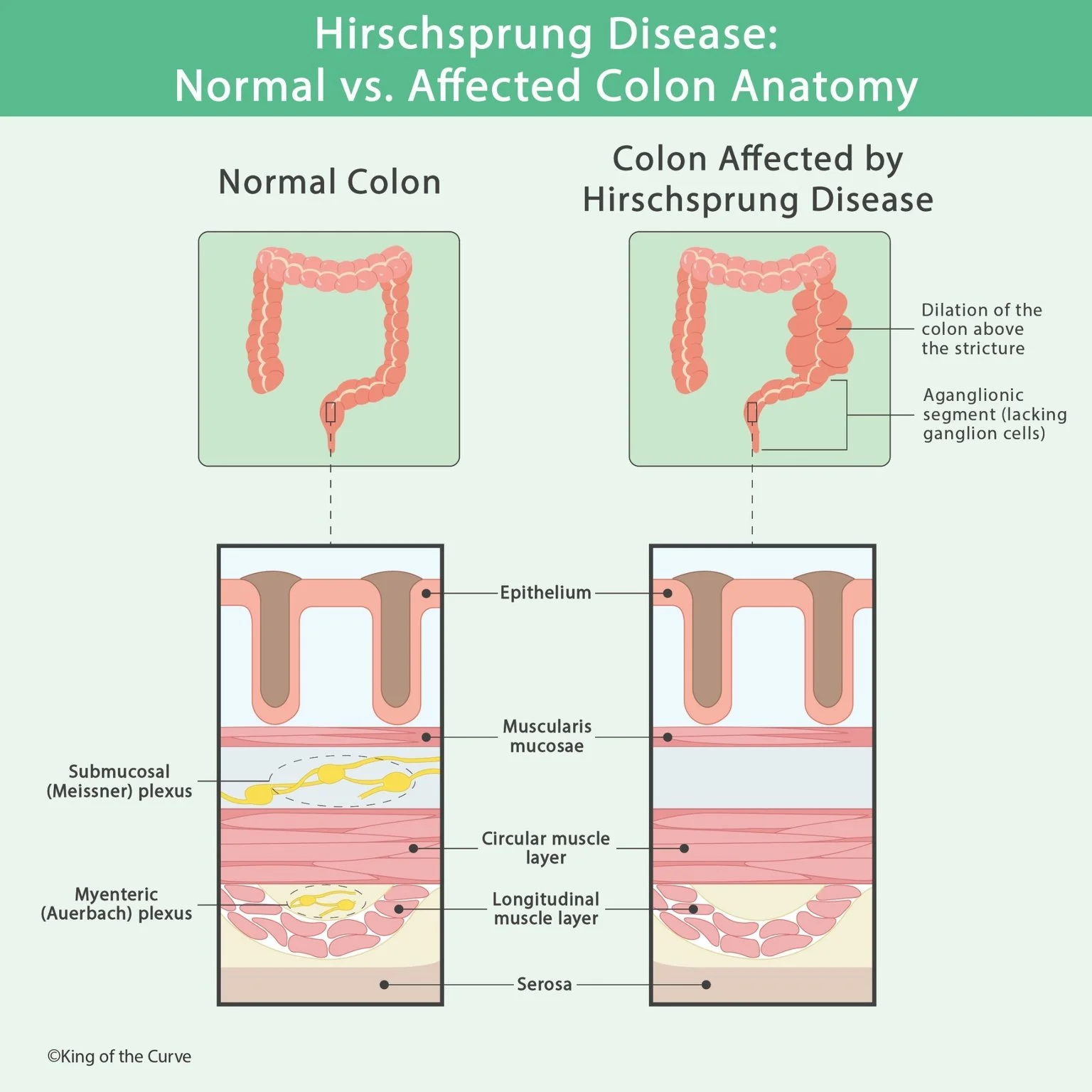🧠 Hirschsprung Disease: Normal vs. Affected Colon Anatomy
Hirschsprung Disease (Congenital Aganglionic Megacolon) is a congenital disorder that affects bowel motility due to absent ganglion cells in the distal colon. This prevents normal relaxation of the colon wall, causing a functional obstruction and proximal dilation.
💡 The Mechanism
In a normal colon, the submucosal (Meissner) plexus and myenteric (Auerbach) plexus coordinate peristalsis and secretion.
In Hirschsprung Disease, neural crest cells fail to migrate to the distal colon during embryonic development. This leads to:
Absence of enteric ganglion cells
Failure of smooth muscle relaxation in the affected segment
Functional obstruction and massive proximal dilation
📚 Clinical Presentation
Newborns with delayed passage of meconium (>48 hours)
Abdominal distension and bilious vomiting
Explosive stool release after rectal exam (“squirt sign”)
Tight empty rectum on exam
🧬 Associated Conditions
Down Syndrome (Trisomy 21)
RET gene mutations
Male predominance
🧾 Diagnostic Overview
| Diagnostic Step | Finding | Explanation |
|---|---|---|
| Contrast Enema | Transition zone (narrow distal, dilated proximal) | Radiographic hallmark suggesting distal aganglionic segment |
| Rectal Biopsy | Absence of ganglion cells | Gold standard confirming aganglionosis |
| Acetylcholinesterase Stain | Increased enzyme activity | Supports diagnosis by highlighting hypertrophic nerve fibers |
💊 Treatment
The mainstay of treatment is surgical resection of the aganglionic segment with a pull-through procedure, restoring continuity of healthy, innervated bowel.
🧠 MCAT & NCLEX Connections
This topic ties into:
MCAT: Neural crest migration, GI development, enteric nervous system
NCLEX: Pediatric nursing care, pre- and post-operative management, fluid/electrolyte monitoring
Board Tip: Compare to Meconium Ileus in Cystic Fibrosis — both cause neonatal obstruction, but only Hirschsprung shows a transition zone and aganglionosis on biopsy.
🎯 Quick Recap Table
| Feature | Normal Colon | Hirschsprung Colon |
|---|---|---|
| Ganglion Cells | Present in both Meissner and Auerbach plexuses | Absent in affected segment |
| Muscle Tone | Normal relaxation during peristalsis | Constant contraction due to lack of relaxation |
| Colon Size | Uniform in caliber throughout | Dilated proximal colon with narrowed distal segment |
| Clinical Presentation | Normal stooling and bowel movement | Delayed meconium, abdominal distension, bilious vomiting |
| Definitive Diagnosis | Not required | Rectal suction biopsy showing absent ganglion cells |
| Treatment | Not applicable | Surgical resection and pull-through procedure |
🧩 Why It Matters
Understanding this concept builds a strong foundation for both MCAT physiology and clinical reasoning on Step 1 and NCLEX. Hirschsprung Disease elegantly integrates developmental biology, GI anatomy, and pathology—making it a high-yield crossover topic.
🚀 Level Up Your Prep
Master visual learning with King of the Curve, the adaptive study app designed for long-term retention and fun learning.
✅ 100K+ Downloads • 🧠 Adaptive Q-Bank • 🎮 Multiplayer Mode • ⏱️ Timed Practice • 💎 Curve Coins & Rewards
Explore more at:
Frequently Asked Questions (FAQs)
-
Aim for 4-6 focused hours, ensuring you incorporate breaks to avoid burnout.
-
Practice mindfulness techniques, take practice exams under realistic conditions, and maintain a balanced lifestyle.
-
Set short-term goals, seek support from mentors, and reward yourself for small achievements.
-
Regular exercise improves focus, reduces stress, and enhances overall mental clarity.
-
KOTC offers personalized learning tools, gamification features, and adaptive question banks to help students stay on track without burnout.


